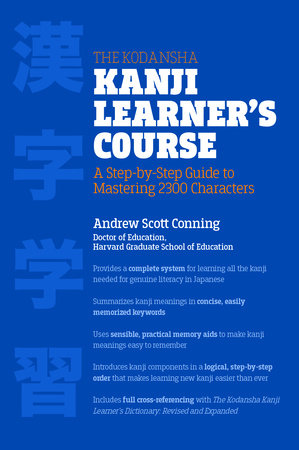The Kodansha Kanji Learner’s Course is an innovative and highly effective system for learning and remembering kanji, or Sino-Japanese characters. The book contains 2,300 character entries, including all 2,136 Joyo Kanji ("regular-use kanji") plus 164 of the most useful non-Joyo Kanji. It offers a sophisticated, pedagogically sound method for remembering the basic meaning(s) of each character, conveniently summarized in concise keywords to facilitate memorization.
Each kanji is accompanied by an explanation of how to remember its meaning(s) clearly and distinctly. These mnemonic explanations teach you to associate each kanji’s graphical form with its unique range of meaning, often by "seeing" its meaning in the form of the kanji itself. An outstanding feature of the course is the special attention it gives to the challenge of learning each kanji in a differentiated way. This allows you to associate the meaning of each character with the features that distinguish it from graphically similar characters.
Another unique feature—and a significant breakthrough in kanji pedagogy—is the sequence in which the course introduces kanji. Most kanji dictionaries and textbooks arrange their entries in ways that do not address the needs of non-native learners, such as by traditional radical or by the grades in which the kanji are taught in Japanese schools.
The Kodansha Kanji Learner’s Course uses an original sequence that presents graphically related characters one after the other to help you give significance to their contrastive features as you learn them, and thereby avoid having to relearn them later. It also introduces the meaning and usage of each graphical element—each kanji building block—the first time it appears, thus enabling you to seamlessly and rapidly acquire new characters. In short,
The Kodansha Kanji Learner’s Course makes learning and remembering kanji easier than ever before.
This book fills an urgent need for a timesaving yet sophisticated kanji-learning system that can be used from beginning through advanced levels—an enjoyable, no-nonsense path to proficiency. It is intended for anyone serious about learning to read Japanese.
Features:
- Includes 2,300 kanji entries
- Completely up-to-date: includes all the 2,136 officially prescribed Joyo Kanji ("kanji for regular use")
- Each entry explains how to remember the character’s meaning clearly and distinctly, often through the innovative use of visualization and concrete imagery
- Introduces kanji components in a logical, step-by-step order that makes learning new kanji easier than ever
- Can be used as a stand-alone resource or together with The Kodansha Kanji Learner’s Dictionary. Includes cross-references, character meanings, readings, and sample vocabulary from the dictionary.





